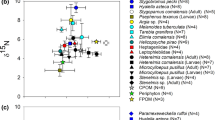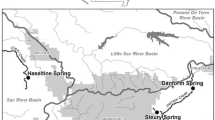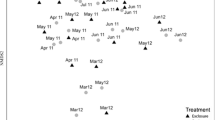Abstract.
We examined the ecosystem functioning and food webs of high elevation springs in or near the Swiss National Park. Springs originated from silicate or carbonate geologies and were near or above treeline. One iron-sulphur and three temporary springs were also included in the study. Ecosystem function was assessed in four springs via measures of bacterial abundance, sediment respiration, nutrient uptake, and ecosystem metabolism. Food webs were assessed in all 20 springs using nutrient content (C, N, P) and stable isotopes of carbon and nitrogen. Bacteria counts ranged from 1.8 to 3.4×108 cells mL−1 sediment with no significant differences between sites. Sediment respiration rates ranged from 0.13 to 0.46 mg O2 h−1 and did not differ between springs. Uptake lengths for N ranged from 11 to 63 m, and for phosphorus from 4 to 60 m. Nitrogen uptake rates (U) ranged from 57 to 266 μg m−2 h−1 and those for P from 0.11 to 4.2 μg m−2 h−1. Gross primary production (GPP) ranged from 0.7 to 7.1 g O2 m−2 d−1, but reached values of 59.1–70.9 g O2m−2 d−1 in the iron-sulphur spring. Ecosystem respiration (ER) ranged from 1.3 to 10.3 g O2m−2 d−1, but was 91.1–101.8 g O2m−2 d−1 in the ironsulphur spring. All four springs were net-heterotrophic with production to respiration ratios (P/R) ranging from 0.48 to 0.72. The percentage C, N, and P varied significantly among the different food web compartments. The molar ratios (C:P,C:N,N:P) of the different nutrients were consistent within compartments, although varying among the different compartments. Stable isotope signatures (δ13C, d15N) were related to the specific spring types, although food webs were relatively simple with most benthic invertebrates showing omnivory. Riparian spiders partially used aquatic insects in the diet. The results suggest that these alpine springs are complex but functionally similar to forested headwater streams with simple food webs.
Similar content being viewed by others
Author information
Authors and Affiliations
Corresponding author
Additional information
Received: 29 April 2008; revised manuscript accepted: 26 August 2008
Rights and permissions
About this article
Cite this article
Robinson, C.T., Schmid, D., Svoboda, M. et al. Functional measures and food webs of high elevation springs in the Swiss alps. Aquat. Sci. 70, 432–445 (2008). https://doi.org/10.1007/s00027-008-8125-y
Published:
Issue Date:
DOI: https://doi.org/10.1007/s00027-008-8125-y




